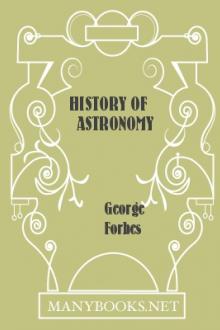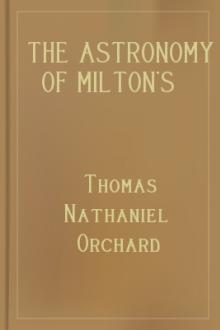History of Astronomy by George Forbes (classic children's novels TXT) 📕

- Author: George Forbes
- Performer: -
Book online «History of Astronomy by George Forbes (classic children's novels TXT) 📕». Author George Forbes
At the close of the fifteenth century King Alphonso of Spain employed computers to produce the Alphonsine Tables (1488 A.D.), Purbach translated Ptolemy’s book, and observations were carried out in Germany by Müller, known as Regiomontanus, and Waltherus.
Nicolai Copernicus, a Sclav, was born in 1473 at Thorn, in Polish Prussia. He studied at Cracow and in Italy. He was a priest, and settled at Frauenberg. He did not undertake continuous observations, but devoted himself to simplifying the planetary systems and devising means for more accurately predicting the positions of the sun, moon, and planets. He had no idea of framing a solar system on a dynamical basis. His great object was to increase the accuracy of the calculations and the tables. The results of his cogitations were printed just before his death in an interesting book, De Revolutionibus Orbium Celestium. It is only by careful reading of this book that the true position of Copernicus can be realised. He noticed that Nicetas and others had ascribed the apparent diurnal rotation of the heavens to a real daily rotation of the earth about its axis, in the opposite direction to the apparent motion of the stars. Also in the writings of Martianus Capella he learnt that the Egyptians had supposed Mercury and Venus to revolve round the sun, and to be carried with him in his annual motion round the earth. He noticed that the same supposition, if extended to Mars, Jupiter, and Saturn, would explain easily why they, and especially Mars, seem so much brighter in opposition. For Mars would then be a great deal nearer to the earth than at other times. It would also explain the retrograde motion of planets when in opposition.
We must here notice that at this stage Copernicus was actually confronted with the system accepted later by Tycho Brahe, with the earth fixed. But he now recalled and accepted the views of Pythagoras and others, according to which the sun is fixed and the earth revolves; and it must be noted that, geometrically, there is no difference of any sort between the Egyptian or Tychonic system and that of Pythagoras as revived by Copernicus, except that on the latter theory the stars ought to seem to move when the earth changes its position—a test which failed completely with the rough means of observation then available. The radical defect of all solar systems previous to the time of Kepler (1609 A.D.) was the slavish yielding to Plato’s dictum demanding uniform circular motion for the planets, and the consequent evolution of the epicycle, which was fatal to any conception of a dynamical theory.
Copernicus could not sever himself from this obnoxious tradition.[5] It is true that neither the Pythagorean nor the Egypto-Tychonic system required epicycles for explaining retrograde motion, as the Ptolemaic theory did. Furthermore, either system could use the excentric of Hipparchus to explain the irregular motion known as the equation of the centre. But Copernicus remarked that he could also use an epicycle for this purpose, or that he could use both an excentric and an epicycle for each planet, and so bring theory still closer into accord with observation. And this he proceeded to do.[6] Moreover, observers had found irregularities in the moon’s motion, due, as we now know, to the disturbing attraction of the sun. To correct for these irregularities Copernicus introduced epicycle on epicycle in the lunar orbit.
This is in its main features the system propounded by Copernicus. But attention must, to state the case fully, be drawn to two points to be found in his first and sixth books respectively. The first point relates to the seasons, and it shows a strange ignorance of the laws of rotating bodies. To use the words of Delambre,[7] in drawing attention to the strange conception,
he imagined that the earth, revolving round the sun, ought always to show to it the same face; the contrary phenomena surprised him: to explain them he invented a third motion, and added it to the two real motions (rotation and orbital revolution). By this third motion the earth, he held, made a revolution on itself and on the poles of the ecliptic once a year … Copernicus did not know that motion in a straight line is the natural motion, and that motion in a curve is the resultant of several movements. He believed, with Aristotle, that circular motion was the natural one.
Copernicus made this rotation of the earth’s axis about the pole of the ecliptic retrograde (i.e., opposite to the orbital revolution), and by making it perform more than one complete revolution in a year, the added part being 1/26000 of the whole, he was able to include the precession of the equinoxes in his explanation of the seasons. His explanation of the seasons is given on leaf 10 of his book (the pages of this book are not all numbered, only alternate pages, or leaves).
In his sixth book he discusses the inclination of the planetary orbits to the ecliptic. In regard to this the theory of Copernicus is unique; and it will be best to explain this in the words of Grant in his great work.[8] He says:—
Copernicus, as we have already remarked, did not attack the principle of the epicyclical theory: he merely sought to make it more simple by placing the centre of the earth’s orbit in the centre of the universe. This was the point to which the motions of the planets were referred, for the planes of their orbits were made to pass through it, and their points of least and greatest velocities were also determined with reference to it. By this arrangement the sun was situate mathematically near the centre of the planetary system, but he did not appear to have any physical connexion with the planets as the centre of their motions.
According to Copernicus’ sixth book, the planes of the planetary orbits do not pass through the sun, and the lines of apses do not pass through to the sun.
Such was the theory advanced by Copernicus: The earth moves in an epicycle, on a deferent whose centre is a little distance from the sun. The planets move in a similar way on epicycles, but their deferents have no geometrical or physical relation to the sun. The moon moves on an epicycle centred on a second epicycle, itself centred on a deferent, excentric to the earth. The earth’s axis rotates about the pole of the ecliptic, making one revolution and a twenty-six thousandth part of a revolution in the sidereal year, in the opposite direction to its orbital motion.
In view of this fanciful structure it must be noted, in fairness to Copernicus, that he repeatedly states that the reader is not obliged to accept his system as showing the real motions; that it does not matter whether they be true, even approximately, or not, so long as they enable us to compute tables from which the places of the planets among the stars can be predicted.[9] He says that whoever is not satisfied with this explanation must be contented by being told that “mathematics are for mathematicians” (Mathematicis mathematica scribuntur).
At the same time he expresses his conviction over and over again that the earth is in motion. It is with him a pious belief, just as it was with Pythagoras and his school and with Aristarchus. “But” (as Dreyer says in his most interesting book, Tycho Brahe) “proofs of the physical truth of his system Copernicus had given none, and could give none,” any more than Pythagoras or Aristarchus.
There was nothing so startlingly simple in his system as to lead the cautious astronomer to accept it, as there was in the later Keplerian system; and the absence of parallax in the stars seemed to condemn his system, which had no physical basis to recommend it, and no simplification at all over the Egypto-Tychonic system, to which Copernicus himself drew attention. It has been necessary to devote perhaps undue space to the interesting work of Copernicus, because by a curious chance his name has become so widely known. He has been spoken of very generally as the founder of the solar system that is now accepted. This seems unfair, and on reading over what has been written about him at different times it will be noticed that the astronomers—those who have evidently read his great book—are very cautious in the words with which they eulogise him, and refrain from attributing to him the foundation of our solar system, which is entirely due to Kepler. It is only the more popular writers who give the idea that a revolution had been effected when Pythagoras’ system was revived, and when Copernicus supported his view that the earth moves and is not fixed.
It may be easy to explain the association of the name of Copernicus with the Keplerian system. But the time has long passed when the historian can support in any way this popular error, which was started not by astronomers acquainted with Kepler’s work, but by those who desired to put the Church in the wrong by extolling Copernicus.
Copernicus dreaded much the abuse he expected to receive from philosophers for opposing the authority of Aristotle, who had declared that the earth was fixed. So he sought and obtained the support of the Church, dedicating his great work to Pope Paul III. in a lengthy explanatory epistle. The Bishop of Cracow set up a memorial tablet in his honour.
Copernicus was the most refined exponent, and almost the last representative, of the Epicyclical School. As has been already stated, his successor, Tycho Brahe, supported the same use of epicycles and excentrics as Copernicus, though he held the earth to be fixed. But Tycho Brahe was eminently a practical observer, and took little part in theory; and his observations formed so essential a portion of the system of Kepler that it is only fair to include his name among these who laid the foundations of the solar system which we accept to-day.
In now taking leave of the system of epicycles let it be remarked that it has been held up to ridicule more than it deserves. On reading Airy’s account of epicycles, in the beautifully clear language of his Six Lectures on Astronomy, the impression is made that the jointed bars there spoken of for describing the circles were supposed to be real. This is no more the case than that the spheres of Eudoxus and Callippus were supposed to be real. Both were introduced only to illustrate the mathematical conception upon which the solar, planetary, and lunar tables were constructed. The epicycles represented nothing more nor less than the first terms in the Fourier series, which in the last century has become a basis of such calculations, both in astronomy and physics generally.
[Illustration: “QUADRANS MURALIS SIVE TICHONICUS.” With portrait of Tycho Brahe, instruments, etc., painted on the wall; showing assistants using the sight, watching the clock, and recording. (From the author’s copy of the Astronomiæ Instauratæ Mechanica.)]
FOOTNOTES:
[1] For definition see p. 22.
[2] Ibid.
[3] For definition see p. 18.
[4] For definition see p. 18.
[5] In his great book Copernicus says: “The movement of the heavenly bodies is uniform, circular, perpetual, or else composed of circular movements.” In this he proclaimed himself a follower of Pythagoras (see p. 14), as also when he says: “The world is spherical because the sphere is, of all figures, the most perfect” (Delambre, Ast. Mod. Hist., pp. 86, 87).
[6] Kepler tells us that Tycho Brahe was pleased with this device, and adapted it to his own system.





Comments (0)